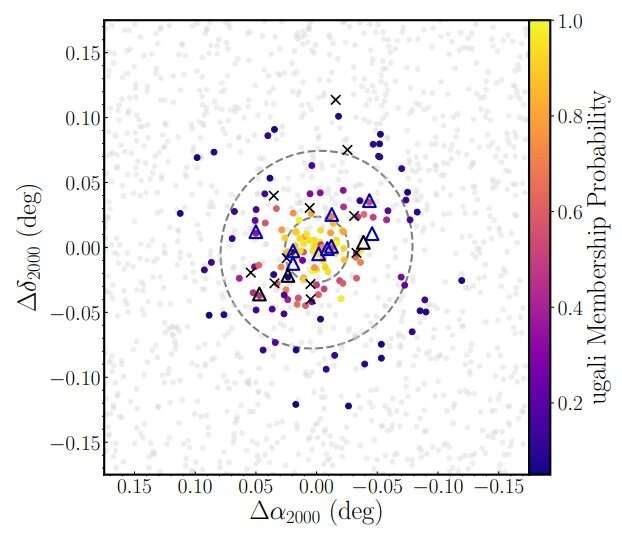March 29, 2022 report
Astronomers discover a new ultra-faint dwarf galaxy

An international team of astronomers reports the discovery of a new ultra-faint dwarf galaxy as part of the DECam Local Volume Exploration (DELVE) survey. The newly found galaxy, designated Pegasus IV, has an absolute magnitude of -4.25. The finding was detailed in a paper published March 22 on arXiv.org.
The so-called ultra-faint dwarf galaxies (UFDs) are the least luminous, most dark matter dominated, and least chemically evolved galaxies known. Therefore, they are perceived by astronomers as the best candidate fossils from the universe at its early stages.
Now, a group of astronomers led by William Cerny of the University of Chicago, Illinois, has found a new UFD that turns out to be a satellite of the Milky Way galaxy. The discovery was made using the data from the Dark Energy Camera (DECam) as part of DELVE—an ongoing multi-component observational campaign seeking to achieve deep, contiguous coverage of the high-Galactic-latitude southern sky.
"In this work, we present the discovery and characterization of yet another ultra-faint Milky Way satellite by DELVE. This new system, Pegasus IV, lies at the very northern edge of sky accessible to the Dark Energy Camera (DECam) in a region previously covered at a shallower depth by the Sloan Digital Sky Survey (SDSS) and the Panoramic Survey Telescope and Rapid Response System 1 survey (PS1)," the researchers wrote in the paper.
The newfound UFD Pegasus IV is a compact, old, ultra-faint stellar system. The results show that this UFD is at least 12.5 billion years old, its half-light radius is about 133.7 light years, and has an absolute (integrated) V-band magnitude at a level of -4.25. The stellar mass of the system was calculated to be around 4,400 solar masses.
According to the paper, Pegasus IV has a velocity dispersion of 3.3 km/s, while its heliocentric velocity is -273.6 km/s. These results, together with the measured proper motion of Pegasus IV, suggest that this UFD is on an elliptical, retrograde orbit, and is currently near its orbital apocenter.
As part of the study, Cenry's team derived iron abundances for five stars of Pegasus IV, which yielded a metallicity of approximately -2.67. This means that the newly found galaxy is one of the most metal-poor ultra-faint dwarfs. The astronomers added that Pegasus IV exhibits a metallicity spread further confirming its nature as a dwarf galaxy.
Furthermore, the researchers managed to constrain the distance to Pegasus IV using a metallicity-absolute magnitude relation for two RR Lyrae stars found in this system. They found that Pegasus IV is located at a distance of about 293,000 light years away from the Earth.
Summing up the results, the authors of the paper noted that their discovery shows how incomplete the census of Milky Way satellites is. They assume that many such faint systems may be still undetected within the distance of 300,000 light years from our planet.
More information: W. Cerny et al, Pegasus IV: Discovery and Spectroscopic Confirmation of an Ultra-Faint Dwarf Galaxy in the Constellation Pegasus. arXiv:2203.11788v1 [astro-ph.GA], arxiv.org/abs/2203.11788
© 2022 Science X Network




















